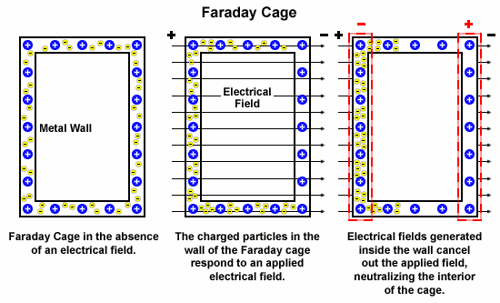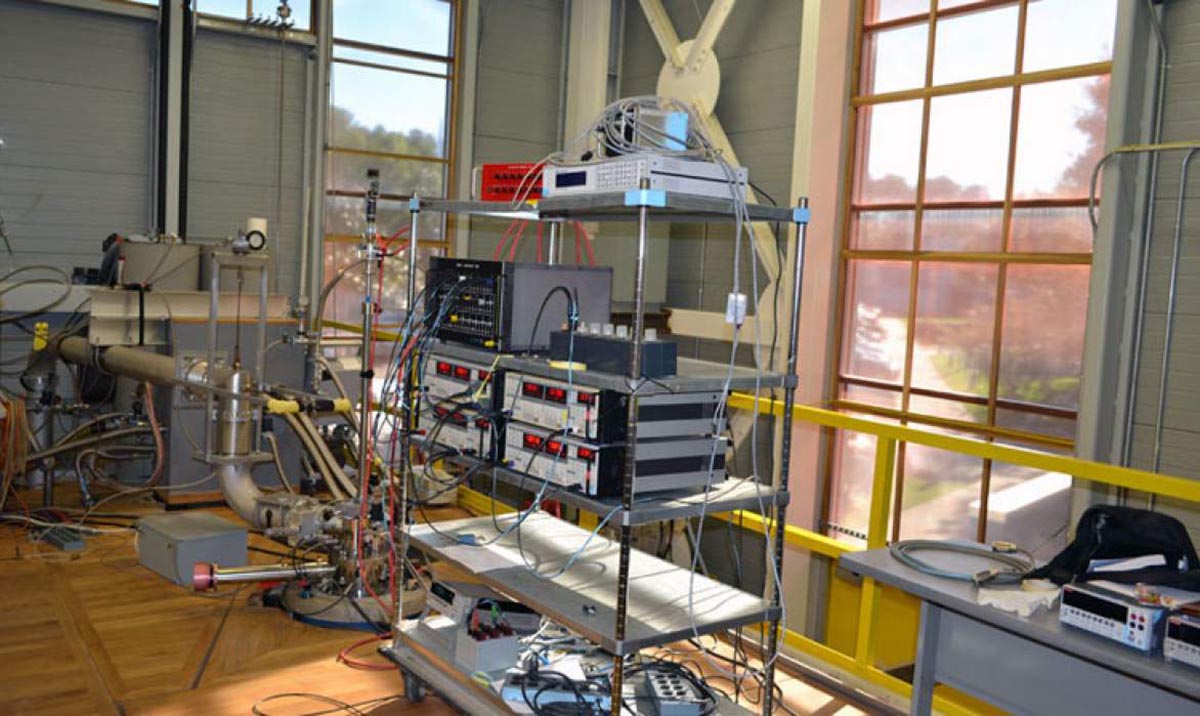Faraday cages are structures – as small as a shoebox or as big as a building — that protect what's inside from surrounding electromagnetic radiation (EM).
We're surrounded by invisible electromagnetic radiation in the form of AM and FM radio waves, visible light, microwaves, ultraviolet rays and other sources. Mostly, we benefit from these waves in the form of microwavable popcorn, tunes over the car radio, and the very light that allows us to see.

Some scientists, however, want none of it, because they conduct experiments so sensitive that the energy from these waves interferes with their work. The only way to escape this interference is by putting themselves in a cage – a Faraday cage.
These structures are named after Michael Faraday, a legend in the history of science in general, and electromagnetism in particular. In the 1830s, the Englishman lined a room in metal foil and bombarded it with electricity produced by an electrostatic generator. An electroscope inside the room confirmed what Faraday suspected: The room was devoid of electrical charge. As it turned out, only the very surface of the metal foil conducted the current. The movement of electrons along the surface of the metal served to create an electrically neutral area inside the cage. This is how cars protect you from lightning: The charge is conducted along the outer layer of the metal but does not penetrate inside the vehicle.

Faraday cages protect not just from static electrical charge but also from electromagnetic waves; this is known as electromagnetic shielding. The materials used to make your cage depend on the length of waves you're trying to keep out (those with long wavelengths and low frequencies, like radio waves, or shorter wavelengths and higher frequencies, like X-rays) and to what degree you need to exclude them. In the MagLab's High B/T Facility at the University of Florida's Microkelvin Laboratory in Gainesville, for example, all electromagnetic waves must be excluded. The magnet there is in a "tempest" quality shielded room, featuring walls made of layers of copper and welded steel that absorb the entire spectrum of EM radiation. Experiments there are conducted at extremely low temperatures, just microkelvins above absolute zero. (A Kelvin is a unit scientists use for measuring temperature; absolute zero is an absolute lack of any atomic movement, of any heat whatsoever … it is as cold as cold can be, colder than any naturally occurring place in our solar system).
At the MagLab's Millikelvin Facility in Tallahassee, scientists also conduct sensitive experiments, though not as sensitive to ambient radio frequencies as those at the High B/T Facility. (In the Millikelvin Facility, experiments can be kept within 7 thousandths of a Kelvin above absolute zero; in the Microkelvin Facility, they can be kept within 40 millionths of a Kelvin above absolute zero!)
The original construction of the Millikelvin Facility did not include electromagnetic shielding. Over time users began reporting interference with their experiments that they could not account for from other likely sources. They suspected electromagnetic radiation was penetrating the facility, traveling into the experimental space via wires that connect the experiments to measurement equipment and computers, and interfering with the measurements.
But Lab staffers couldn't figure out why the Millikelvin Facility seemed to be affected by the suspected electromagnetic radiation more so than other experimental locations within the MagLab.
Eventually, the answer became as clear as glass: Unlike other experimental areas, the Millikelvin Facility has lots of windows. In fact, 450 square feet of the facility is covered in glass. The electromagnetic radiation from nearby radio stations, the airport and other sources was coming right through those windows, just as if they were open, allowing the incident RF energy to sneak past the surrounding metal walls. Deciding to sacrifice the view in the name of science, the Millikelvin and Facilities staff covered the windows in fine copper mesh, blocking the electromagnetic waves' easy access and functioning as a Faraday cage.
The result? Before blocking the windows, the ambient RF power level in the facility — the cumulative energy of all those electromagnetic waves — was about the same as it was outside in the parking lot. After the copper mesh was installed, the ambient power was reduced it by a factor of 100.
How it works
Electromagnetic waves are two waves in one. An electrical wave creating an electrical field moves along one plane, and a magnetic wave creating a magnetic field that moves perpendicular to the electrical field, as shown below. The two fields feed off each other, creating a self-propagating wave.

Both of these fields are thwarted by the Faraday cage, but in different ways.
The electric field is diverted in the way discovered in Faraday's 1830s experiment. The field causes the electrons in the metal of the cage to rearrange, neutralizing any charge within the cage. Faraday also illustrated this phenomenon with an ice pail.
When magnetic waves come in contact with the Faraday cage, they create a current in the conductor known as an eddy current. (A moving magnetic field always generates a current in conductors — that's called electromagnetic induction). These eddy currents, in turn, create magnetic fields that oppose the field of the oncoming waves. So those waves are blocked from the interior of the cage.
Thanks to DC Field Facility Director Tim Murphy, the scientific advisor on this page.
By Kristen Coyne



